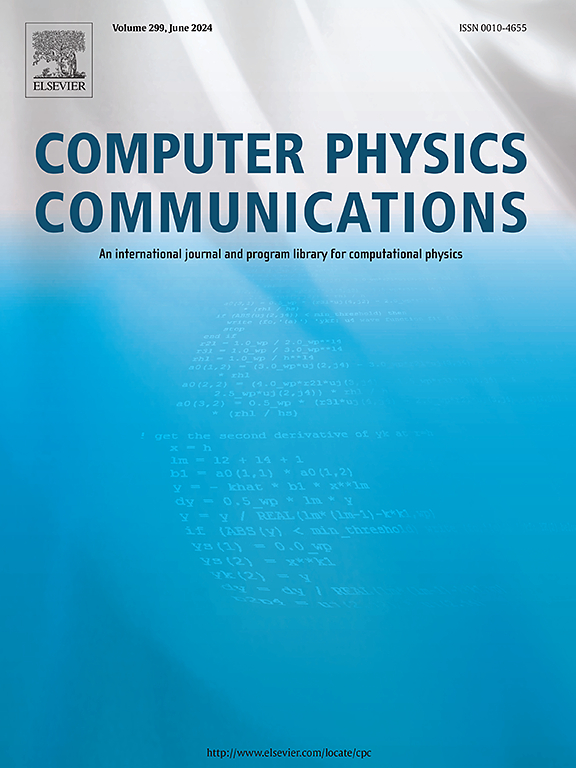A new way to use nonlocal symmetries to determine first integrals of second-order nonlinear ordinary differential equations
IF 3.4
2区 物理与天体物理
Q1 COMPUTER SCIENCE, INTERDISCIPLINARY APPLICATIONS
引用次数: 0
Abstract
Finding first integrals of second-order nonlinear ordinary differential equations (nonlinear 2ODEs) is a very difficult task. In very complicated cases, where we cannot find Darboux polynomials (to construct an integrating factor) or a Lie symmetry (that allows us to simplify the equations), we sometimes can solve the problem by using a nonlocal symmetry. In [1], [2], [3] we developed (and improved) a method (S-function method) that is successful in finding nonlocal Lie symmetries to a large class of nonlinear rational 2ODEs. However, even with the nonlocal symmetry, we still need to solve a 1ODE (which can be very difficult to solve) to find the first integral. In this work we present a novel way of using the nonlocal symmetry to compute the first integral with a very efficient linear procedure.
New version program summary
Program Title: InSyDE – Invariants and Symmetries of (rational second order ordinary) Differential Equations.
CPC Library link to program files: https://doi.org/10.17632/4ytft6zgk7.3
Licensing provisions: CC by NC 3.0
Programming language: Maple
Supplementary material: Theoretical results and revision of the S-function method.
Journal reference of previous version: Comput. Phys. Comm. Volume 234, January 2019, Pages 302-314 - https://doi.org/10.1016/j.cpc.2018.05.009
Does the new version supersede the previous version?: Yes.
Nature of problem: Determining first integrals of rational second order ordinary differential equations.
Solution method: The method is explained in the Summary of revisions and Supplementary material.
Reasons for the new version: The InSyDE package after determining the S-function still needs to solve a first-order ordinary differential equation (1ODE) associated with the nonlocal symmetry (the so-called associated 1ODE – see [2]). The problem is that, for very complicated 1ODEs, this may not be practically feasible. We have developed an new and more efficient method that uses the nonlocal symmetry to (for a large class of 1ODEs) determine the first integral in a linear way.
Summary of revisions: In order to implement the new method just mentioned above we have made modifications to the command (Sfunction) and introduced a new one: command (Darlin).
利用非局部对称性确定二阶非线性常微分方程第一积分的新方法
寻找二阶非线性常微分方程(非线性 2ODEs )的初等积分是一项非常困难的任务。在非常复杂的情况下,如果我们找不到达布多项式(用于构造积分因子)或 Lie 对称性(允许我们简化方程),有时我们可以利用非局部对称性来解决问题。在 [1]、[2]、[3] 中,我们开发(并改进)了一种方法(S 函数法),成功地为一大类非线性有理 2ODE 找到了非局部 Lie 对称性。然而,即使有了非局部对称性,我们仍然需要求解 1ODE (可能非常难以求解)以找到第一积分。在这项工作中,我们提出了一种利用非局部对称性的新方法,通过非常高效的线性过程计算第一积分:InSyDE - Invariants and Symmetries of (rational second order ordinary) Differential Equations.CPC Library link to program files: https://doi.org/10.17632/4ytft6zgk7.3Licensing provisions:CC by NC 3.0编程语言:Maple 补充材料:Theoretical results and revision of the S-function method.Journal reference of previous version:Comput.Phys.第 234 卷,2019 年 1 月,第 302-314 页 - https://doi.org/10.1016/j.cpc.2018.05.009Does 新版本是否取代旧版本?是.问题性质:确定有理二阶常微分方程的第一次积分.求解方法:问题性质:求有理二阶常微分方程的初等积分:InSyDE 软件包在确定 S 函数后仍需要求解与非局部对称性相关的一阶常微分方程(1ODE)(即所谓的相关 1ODE - 参见 [2])。问题是,对于非常复杂的 1ODE 而言,这在实践中可能并不可行。我们开发了一种新的、更有效的方法,利用非局部对称性(对于一大类 1ODEs 来说)以线性方式确定第一积分:为了实现上述新方法,我们修改了指令 (Sfunction),并引入了一个新指令:指令 (Darlin)。
本文章由计算机程序翻译,如有差异,请以英文原文为准。
求助全文
约1分钟内获得全文
求助全文
来源期刊

Computer Physics Communications
物理-计算机:跨学科应用
CiteScore
12.10
自引率
3.20%
发文量
287
审稿时长
5.3 months
期刊介绍:
The focus of CPC is on contemporary computational methods and techniques and their implementation, the effectiveness of which will normally be evidenced by the author(s) within the context of a substantive problem in physics. Within this setting CPC publishes two types of paper.
Computer Programs in Physics (CPiP)
These papers describe significant computer programs to be archived in the CPC Program Library which is held in the Mendeley Data repository. The submitted software must be covered by an approved open source licence. Papers and associated computer programs that address a problem of contemporary interest in physics that cannot be solved by current software are particularly encouraged.
Computational Physics Papers (CP)
These are research papers in, but are not limited to, the following themes across computational physics and related disciplines.
mathematical and numerical methods and algorithms;
computational models including those associated with the design, control and analysis of experiments; and
algebraic computation.
Each will normally include software implementation and performance details. The software implementation should, ideally, be available via GitHub, Zenodo or an institutional repository.In addition, research papers on the impact of advanced computer architecture and special purpose computers on computing in the physical sciences and software topics related to, and of importance in, the physical sciences may be considered.
 求助内容:
求助内容: 应助结果提醒方式:
应助结果提醒方式:


